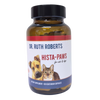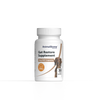A “sensitive stomach” isn’t a diagnosis but rather a set of symptoms, such as vomiting, diarrhea, constipation, or frequent hairballs, that often point to an underlying gastrointestinal (GI) issue. Cats may develop food sensitivities, intolerances, or even inflammatory conditions that make it harder for them to digest certain ingredients.
Research shows that dietary factors can significantly impact the gut microbiome, which plays a key role in digestion and overall health. When the gut is out of balance, it can trigger inflammation, poor nutrient absorption, and ongoing stomach upset.
So, what can you do? The right diet can make all the difference. Below are some of the most effective nutritional approaches for cats with sensitive stomachs.
1. Fresh, Home-Cooked Diets
For cats with digestive issues, fresh, gently cooked meals are often the easiest to tolerate. The Original CrockPet Diet is designed specifically for this:
-
Lean proteins like chicken, turkey, or fish
-
Small amounts of butternut squash or pumpkin for fiber
-
Healthy fats such as fish oil
Cooking at home allows you to control every ingredient and remove potential irritants, which is especially important if raw diets have been causing problems.
2. Limited Ingredient Diets (LID)
If home cooking isn’t realistic, consider a limited ingredient diet. These formulas typically use a single protein source and minimal extras, lowering the risk of sensitivities. Some also feature novel proteins like duck, venison, or rabbit, which can be helpful if your cat has already reacted to common proteins such as chicken or beef.
3. Grain-Free Options
Many cats struggle with fillers like corn, wheat, or soy. A grain-free formula that emphasizes animal protein can be easier on the stomach. Just make sure it’s not overloaded with potatoes or legumes, as these can also be tough to digest.
4. Wet Food Over Dry Food
Cats with sensitive stomachs often do better on wet food because it’s easier to digest and provides much-needed hydration. Dry kibble can be harder on the digestive system and may contain more fillers. Look for foods with high moisture content and simple, high-quality ingredients.
5. Probiotic-Enriched Foods
Probiotics are a powerful tool for balancing gut health. They help restore a healthy microbiome, reduce inflammation, and improve digestion. You can pair a home-cooked diet with a high-quality, pet-specific probiotic supplement to support long-term GI health.
6. Elimination Diets
If symptoms don’t improve, an elimination diet may be needed. Start with one novel protein and carbohydrate your cat hasn’t eaten before (like duck and peas), then slowly reintroduce ingredients to identify the culprit. This takes time but can be the most reliable way to uncover triggers.
7. Avoid Common Irritants
Certain ingredients are more likely to upset sensitive stomachs, including:
-
Artificial preservatives, colors, and flavors
-
By-products or low-quality meat meals
-
Dairy products (most cats are lactose intolerant)
-
Excessive carbohydrates or fillers
8. Transition Slowly
When switching to a new food, always transition gradually over 7–10 days. Start by mixing a small amount of the new food with the old, gradually increasing the proportion of the new food. This helps your cat’s digestive system adjust and reduces the risk of further upset.
Recommended Options
If your cat has a sensitive stomach, focus on nutrients and food components that support gentle digestion and gut health:
-
High-Quality Protein: Choose lean, easily digestible proteins such as chicken, turkey, fish, or novel proteins like duck or rabbit. Protein should be the foundation of the diet.
-
Moderate, Digestible Fiber: Ingredients like pumpkin, butternut squash, or small amounts of green vegetables provide fiber to regulate digestion without being too harsh.
-
Healthy Fats: Omega-3 fatty acids from sources like fish oil can reduce inflammation in the GI tract and support overall gut health.
-
Moisture: Adequate hydration is essential for digestion and urinary tract health. Adding water or broth to meals helps increase fluid intake.
-
Probiotics: Support a balanced gut microbiome, improve nutrient absorption, and reduce inflammation.
-
Digestive Enzymes: These can help break down food more efficiently, reducing strain on a sensitive digestive system.
-
Essential Vitamins and Minerals: Ensure the diet is balanced with taurine (critical for heart and eye health), B vitamins for energy metabolism, and trace minerals like zinc and magnesium to support overall health.
Cats with sensitive stomachs can thrive once you find the right dietary approach. The key is keeping things simple, gentle, and nourishing. Fresh, home-cooked meals give you the most control, allowing you to avoid irritants and tailor nutrition to your cat’s needs. Supportive tools like probiotics, slow transitions, and limited ingredients can make a huge difference.
Every cat is unique, so it may take some trial and error, but with patience and the right approach, you can reduce stomach upset, support gut health, and help your cat feel comfortable and happy again.
















